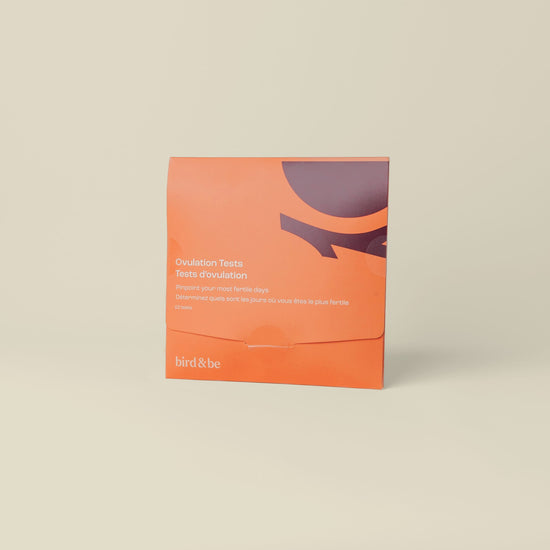Until you start trying, it’s difficult for most of us to predict just how easy (or difficult) getting pregnant will be. Which means that you’re often weighing multiple factors—like your age, relationship status, and overall readiness to grow a family—without much insight into your own fertility. And while having a conversation with your family doctor well before you want to conceive would be great for helping to inform your decisions, we know access (and finding the time!) can be tough. These barriers are the reason why we offer at-home tests. We know from experience that early intervention can make a huge difference in outcomes, and having more information at your fingertips can be helpful. At-home fertility testing can be a first step on your journey, helping you understand your own cycle, screening for any potential pitfalls, and getting you to a doctor sooner if needed.
What are at-home fertility tests?
While some fertility tests need to be done by a clinic (think: ultrasounds and blood draws), others can be done easily at home through, say, a urine or sperm sample. These tests aren’t considered diagnostic but can help to screen for fertility issues.
The pros and cons of at-home fertility tests:
Pros:
-
Often accessibly priced
-
Available without a referral or prescription
-
Can be done in the comfort of your own home
-
Results can be interpreted by you
-
Can be done at any age, at any point in your reproductive journey
-
Can be shared with a doctor to expedite additional care if needed
Cons:
-
Will often require further diagnostic testing to confirm the results
At-home fertility tests can’t tell you everything, but they can provide important insight and help screen for issues that could get you to a doctor quicker, saving you valuable time on your journey.
How to test male fertility at home
Sperm Test
Why it’s helpful
Doing an at-home male fertility test like a sperm test can help identify whether male factor infertility is at play in your fertility journey. Up to 50% of infertility cases are due to issues with sperm, but it’s an often forgotten part of the fertility equation. A sperm test can’t tell you everything (we can’t yet test for sperm DNA fragmentation at home), it can give you some insights (including sperm motility—an important variable if you’re trying to conceive at home).
What’s involved: A sperm sample and 20 minutes
Try it: Bird&Be At-Home Sperm Test gives you male fertility insights in as little as 20 minutes, directly to your smartphone—no need to mail in samples. You get a video of your sperm, along with an assessment, that you can choose to share with a doctor if you have any concerns—and it’s 97% accurate.
Understanding sperm health and how it’s tested →
How to test female fertility at home
Ovarian Reserve Test
Why it’s helpful
Ovarian reserve refers to how many eggs you have left. You’re born with all the eggs you’ll ever have and over time, both the quantity (how many) and the quality (how healthy) decline. Ovarian reserve is how many. While knowing how many eggs you have left can’t predict whether you will successfully get pregnant (it takes just one good-quality egg, after all), it can help inform your timeline (more eggs equals more chances). There are two types of at-home ovarian reserve screening tests: FSH and AMH.
FSH Test: An at-home FSH test (like our Ovarian Reserve Screening Test) is as easy and as fast as a home pregnancy test. You dip the stick in your collected urine and then wait for results, which can take as little as 10 minutes. A higher FSH on day 3 of your cycle can indicate a low ovarian reserve, prompting you to head to your doctor for more investigation.
AMH Test: An at-home AMH test is a blood test—you provide a sample (typically via a finger prick), mail it to a lab and then wait for results, which can take a week or more to receive. The results on this one are less immediate but can offer some diagnostic insight into your ovarian reserve.
What’s involved: A finger prick (AMH) sample mailed into a lab with results in days or weeks, or a urine sample (FSH) tested at home with results in 10 minutes, depending on the type of test.
Try it: The Ovarian Reserve Screening Test is an at-home urine test that measures FSH and is over 99% accurate compared to bloodwork. We provide enough strips to test for 3 days over two cycles—giving you plenty of chances to note any spikes that may require follow-up with your doctor.
What is FSH and How is it Measured?→
Ovulation Test
Why it’s helpful
An ovulation predictor kit (OPK) measures LH, the hormone that surges right before you ovulate. Ovulation tests are a great way to understand when you should be getting busy if you’re trying to get pregnant on your own (hint: it’s right when you see that surge). But it’s a good idea to understand your ovulation and your cycle well before that point. An ovulation test can confirm an LH surge, which typically peaks right before ovulation. If you’re timing intercourse around your OPK results and not getting pregnant, it may be time to check in with a doctor to learn more. If you’re not trying to get pregnant, tracking ovulation can still be beneficial—knowing more about your cycle may help you plan for pregnancy in the future or flag an ovulatory issue sooner.
What’s involved: A urine sample and 10 minutes
Try it: Bird&Be Ovulation Tests are 99.9% accurate and even come with a handy tracker so you know exactly when that LH spike happens. We also pack 10 in a single pack so you can test as often as you want (and we have bulk packs too, if you need them).
What are the signs and symptoms of ovulation? →
While at-home fertility testing can’t replace the expertise of a doctor, these at-home tests are a great first step to learn more about your fertility and to push for an appointment with a doctor sooner, if needed.









